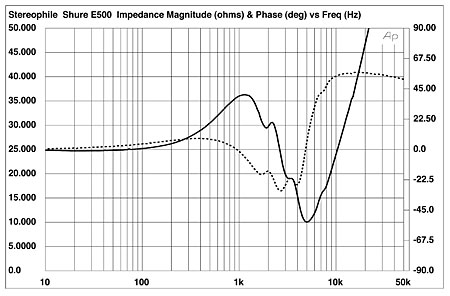| Columns Retired Columns & Blogs |
Shure SE530 in-ear headphones Measurements
Sidebar 3: Measurements
As I've written before, I have no means of assessing the frequency response of headphones—Keith Howard wrote an excellent article on this subject in the October 2007 issue of the British magazine Hi-Fi News—but I did measure the electrical impedance of the Shure SE530s with the headphones inserted in my ears. The measurements will thus include the acoustic loading of my ear canals, which I assume is not too different from the typical Stereophile reader's (though yes, the diameter of my "jumbo" ear canals is larger than average). The result is shown in fig.1. The low-frequency magnitude is 25 ohms, rising to 36 ohms just above 1kHz. The electrical phase angle is moderate over most of the band, and the minimum magnitude is 10 ohms at 5kHz, with then a continuous rise apparent to>50 ohms above the audioband, this presumably due to the drive-unit's inductance.

Fig.1 Shure SE530, electrical impedance (solid) and phase (dashed). (2 ohms/vertical div.)
The Shures will thus be generally easier to drive than the Ultimate Ears UE-10s, which Wes Phillips reviewed in October 2006 . The UE-10s averaged 13 ohms at low frequencies, which made them sound lean in the bass with earlier iPods, which had a rising source impedance below 100Hz due to the physically limited size of the output coupling capacitor. The Ultimates' minimum value of 9 ohms is not too different, however, from the Shures' 10 ohms.—John Atkinson
- Log in or register to post comments




































